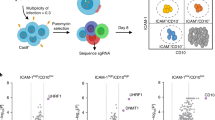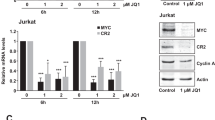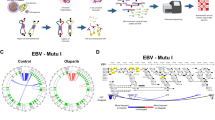Abstract
The Epstein–Barr virus (EBV)-encoded EBNA1 protein is expressed in all virus-associated tumors where it plays an essential role in the maintenance, replication and transcription of the EBV genome. Transcriptional profiling of EBNA1-expressing carcinoma cells demonstrated that EBNA1 also influences the expression of a range of cellular genes including those involved in translation, transcription and cell signaling. Of particular interest was the ability of EBNA1 to enhance expression of STAT1 and sensitize cells to interferon-induced STAT1 activation with resultant enhancement of major histocompatibility complex expression. A negative effect of EBNA1 on the expression of TGFβ1-responsive βig-h3 and PAI-1 genes was confirmed at the protein level in EBV-infected carcinoma cells. This effect resulted from the ability of EBNA1 to repress TGFβ1-induced transcription via a reduction in the interaction of SMAD2 with SMAD4. More detailed analysis revealed that EBNA1 induces a lower steady-state level of SMAD2 protein as a consequence of increased protein turnover. These data show that EBNA1 can influence cellular gene transcription resulting in effects that may contribute to the development of EBV-associated tumors.
This is a preview of subscription content, access via your institution
Access options
Subscribe to this journal
Receive 50 print issues and online access
$259.00 per year
only $5.18 per issue
Buy this article
- Purchase on Springer Link
- Instant access to full article PDF
Prices may be subject to local taxes which are calculated during checkout






Similar content being viewed by others
References
Balkwill F, Mantovani A . (2001). Inflammation and cancer: back to Virchow? Lancet 357: 539–545.
Baumforth KRN, Flavell JR, Reynolds GM, Davies G, Pettitt TR, Wei WB et al. (2005). Induction of autotaxin by the Epstein–Barr virus promotes the growth and survival of Hodgkin's lymphoma cells. Blood 106: 2138–2146.
Cao WP, Tan P, Lee CH, Zhang HF, Lu JH . (2006). A transforming growth factor-β-induced protein stimulates endocytosis and is up-regulated in immature dendritic cells. Blood 107: 2777–2785.
Chen H, Hutt-Fletcher LM, Cao L, Hayward SD . (2003). A positive autoregulatory loop of LMP1 expression and STAT activation in epithelial cells latently infected with Epstein–Barr virus. J Virol 77: 4139–4148.
Chen H, Lee JM, Zong YS, Borowitz M, Ng MH, Ambinder RF et al. (2001). Linkage between STAT regulation and Epstein–Barr virus gene expression in tumours. J Virol 75: 2929–2937.
Chen HL, Lee JM, Wang YL, Huang DP, Ambinder RF, Hayward SD . (1999). The Epstein–Barr virus latency BamHI-Q promoter is positively regulated by STATs and Zta interference with JAK/STAT activation leads to loss of BamHI-Q promoter activity. Proc Natl Acad Sci USA 96: 9339–9344.
Choi SH, Hwang SB . (2006). Modulation of the transforming growth factor-β signal transduction pathway by hepatitis C virus nonstructural 5A protein. J Biol Chem 281: 7468–7478.
Chow LS, Lam CW, Chan SY, Tsao SW, To KF, Tong S-F et al. (2006). Identification of RASSF1A modulated genes in nasopharyngeal carcinoma. Oncogene 25: 310–316.
Chuang TC, Way TD, Lin YS, Lee YC, Law SL, Kao MC . (2002). The Epstein–Barr virus nuclear antigen-1 may act as a transforming suppressor of the HER2/neu oncogene. FEBS Lett 532: 135–142.
Debonneville C, Staub O . (2004). Participation of the ubiquitin-conjugating enzyme UBE2E3 in Nedd4-2-dependent regulation of the epithelial Na+ channel. Mol Cell Biol 24: 2397–2409.
Fakhari FD, Jeong JH, Kanan Y, Dittmer DP . (2006). The latency-associated nuclear antigen of Kaposi sarcoma-associated herpesvirus induces B cell hyperplasia and lymphoma. J Clin Invest 116: 735–742.
Friborg J, Kong WP, Hottinger MO, Nabel GJ . (1999). p53 inhibition by the LANA protein of KSHV protects against cell death. Nature 402: 889–894.
Fujimuro M, Wu FY, ApRhys C, Kajumbula H, Young DB, Hayward GS et al. (2003). A novel viral mechanism for dysregulation of β-catenin in Kaposi's sarcoma-associated herpesvirus latency. Nat Med 9: 300–306.
Fukuda M, Longnecker R . (2004). Latent membrane protein 2A inhibits transforming growth factor-β1-induced apoptosis through the phosphatidylinositol 3-kinase/Akt pathway. J Virol 78: 1697–1705.
Gupta A, Gartner JJ, Sethupathy P, Hatzigeorgiou AG, Fraser NW . (2006). Anti-apoptotic function of a microRNA encoded by the HSV-1 latency-associated transcript. Nature 442: 82–85.
Haider AS, Peters SB, Kaporis H, Cardinale I, Fei J, Ott J et al. (2006). Genomic analysis defines a cancer-specific gene expression signature for human squamous cell carcinoma and distinguishes malignant hyperproliferation from benign hyperplasia. J Invest Dermatol 126: 869–881.
Harn HJ, Fan HC, Chen CJ, Tsai NM, Yen CY, Huang SC . (2002). Microsatellite alteration at chromosome 11 in primary human nasopharyngeal carcinoma in Taiwan. Oral Oncol 38: 23–29.
Holowaty MN, Zeghouf M, Wu H, Tellam J, Athanasopoulos V, Greenblatt J et al. (2003). Protein profiling with Epstein–Barr nuclear antigen-1 reveals an interaction with the herpesvirus-associated ubiquitin-specific protease HAUSP/USP7. J Biol Chem 278: 29987–29994.
Huibregtse JM, Scheffner M, Howley PM . (1991). A cellular protein mediates association of P53 with the E6 oncoprotein of human papillomavirus type-16 or type-18. EMBO J 10: 4129–4135.
Humme S, Reisbach G, Feederle R, Delecluse HJ, Bousset K, Hammerschmidt W et al. (2003). The EBV nuclear antigen1 (EBNA1) enhances B cell immortalisation several thousand-fold. Proc Natl Acad Sci USA 100: 10989–10994.
Kang MS, Hung SC, Kieff E . (2001). Epstein–Barr virus nuclear antigen 1 activates transcription from episomal but not integrated DNA and does not alter lymphocyte growth. Proc Natl Acad Sci USA 98: 15233–15238.
Kang MS, Lu HX, Yasui T, Sharpe A, Warren H, Cahir-McFarland E et al. (2005). Epstein–Barr virus nuclear antigen 1 does not induce lymphoma in transgenic FVB mice. Proc Natl Acad Sci USA 102: 820–825.
Kennedy G, Komano J, Sugden B . (2003). Epstein–Barr virus provides a survival factor to Burkitt's lymphomas. Proc Natl Acad Sci USA 100: 14269–14274.
Kieff E, Rickinson AB . (2001). Epstein–Barr virus and its replication. In: Knipe Dm, Howley Pm (eds). Fields Virology. Lippincott Williams & Wilkins: Philadelphia, pp 2511–2574.
Komano J, Sugiura M, Takada K . (1998). Epstein–Barr virus contributes to the malignant phenotype and to apoptosis resistance in Burkitt's lymphoma cell line Akata. J Virol 72: 9150–9156.
Kovacic B, Stoiber D, Moriggl R, Weisz E, Ott RG, Kreibich R et al. (2006). STAT1 acts as a tumor promoter for leukemia development. Cancer Cell 10: 77–87.
Kube D, Vockerodt M, Weber O, Hell K, Wolf J, Haier B et al. (1999). Expression of Epstein–Barr virus nuclear antigen 1 is associated with enhanced expression of CD25 in the Hodgkin cell line L428. J Virol 73: 1630–1636.
Kuratomi G, Komuro A, Goto K, Shinozaki M, Miyazawa K, Miyazono K et al. (2005). NEDD4-2 (neural precursor cell expressed, developmentally down-regulated 4-2) negatively regulates TGF-β (transforming growth factor-β) signalling by inducing ubiquitin-mediated degradation of Smad2 and TGF-β type I receptor. Biochem J 386: 461–470.
Lee DK, Kim BC, Kim IY, Cho EA, Satterwhite DJ, Kim SJ . (2002). The human papilloma virus E7 oncoprotein inhibits transforming growth factor-beta signaling by blocking binding or the Smad complex to its target sequence. J Biol Chem 277: 38557–38564.
Lee SP, Brooks JM, Al-Jarrah H, Thomas WA, Haigh RT, Taylor GS et al. (2004). CD8T cell recognition of endogenously expressed Epstein–Barr virus nuclear antigen 1. J Exp Med 199: 1409–1420.
Levitskaya J, Coram M, Levitsky V, Imreh S, Steigerwald-Mullen P, Masucci MG . (1995). Inhibition of antigen processing by the internal repeat region of the Epstein–Barr virus nuclear antigen-1. Nature 375: 685–688.
Liang CL, Chen JL, Hsu YPP, Ou JT, Chang YS . (2002). Epstein–Barr virus BZLF1 gene is activated by transforming growth factor-β through cooperativity of Smads and c-Jun/c-Fos proteins. J Biol Chem 277: 23345–23357.
Liang CL, Tsai CN, Chung PJ, Chen JL, Sun CM, Chen RH et al. (2000). Transcription of Epstein–Barr virus-encoded nuclear antigen 1 promoter Qp is repressed by transforming growth factor-beta via Smad4 binding element in human BL cells. Virology 277: 184–192.
Lo RS, Massague J . (1999). Ubiquitin-dependent degradation of TGF-β-activated Smad2. Nat Cell Biol 1: 472–478.
Mori N, Morishita M, Tsukazaki T, Yamamoto N . (2003). Repression of SMAD-dependent transforming growth factor-β signaling by Epstein–Barr virus latent membrane protein 1 through nuclear factor-κβ. Int J Cancer 105: 661–668.
Munier FL, Korvatska E, Djemai A, LePaslier D, Zografos L, Pescia G et al. (1997). Kerato-epithelin mutations in four 5q31-linked corneal dystrophies. Nat Genet 15: 247–251.
Nam JO, Jeong HW, Lee BH, Park RW, Kim IS . (2005). Regulation of tumor angiogenesis by fastatin, the fourth FAS1 domain of βig-h3 via αvβ3 integrin. Cancer Res 65: 4153–4161.
Oh JE, Kook JK, Min BM . (2005). Big-h3 induces keratinocyte differentiation via modulation of involucrin and transglutaminase expression through the integrin α3β1 and the phosphatidylinositol 3-kinase/Akt signaling pathway. J Biol Chem 280: 21629–21637.
Perk J, Iavarone A, Benezra R . (2005). ID family of helix–loop–helix proteins in cancer. Nat Rev Cancer 5: 603–605.
Raab-Traub N . (2002). Epstein–Barr virus in the pathogenesis of NPC. Semin Cancer Biol 12: 431–441.
Radkov SA, Kellam P, Boshoff C . (2000). The latent nuclear antigen of Kaposi's sarcoma-associated herpesvirus targets the retinoblastoma-E2F pathway and with the oncogene HRAS transforms primary rat cells. Nat Med 6: 1121–1127.
Renne C, Martin-Subero JI, Eickernjager M, Hansmann ML, Kuppers R, Siebert R et al. (2006). Aberrant expression of ID2, a suppressor of B-cell specific gene expression, in Hodgkin's lymphoma. Am J Pathol 169: 655–664.
Rickinson AB, Kieff E . (2001). Epstein–Barr virus. In: Knipe Dm, Howley Pm (eds). Fields Virology. Lippincott Williams and Wilkins: Philadelphia, pp 2575–2627.
Ruf IK, Rhyne PW, Yang C, Cleveland JL, Sample JT . (2000). Epstein–Barr virus small RNAs potentiate tumourigenicity of Burkitt lymphoma cells independently of an effect on apoptosis. J Virol 74: 10223–10228.
Saridakis V, Sheng Y, Sarkari F, Holowaty MN, Shire K, Nguyen T et al. (2005). Structure of the p53 binding domain of HAUSP/USP7 bound to Epstein–Barr nuclear antigen 1: implications for EBV-mediated immortalization. Mol Cell 18: 25–36.
Seo TG, Park JS, Choe JH . (2005). Kaposi's sarcoma – associated herpesvirus viral IFN regulatory factor 1 inhibits transforming growth factor-β signaling. Cancer Res 65: 1738–1747.
Shao GZ, Berenguer J, Borczuk AC, Powell CA, Hei TK, Zhao YL . (2006). Epigenetic inactivation of Betaig-h3 gene in human cancer cells. Cancer Res 66: 4566–4573.
Sheng Y, Saridakis V, Sarkari F, Duan SL, Wu TN, Arrowsmith CH et al. (2006). Molecular recognition of p53 and MDM2 by USP7/HAUSP. Nat Struct Mol Biol 13: 285–291.
Sheu LF, Meng CL, Ho KC, Lee WH, Leu FJ, Chao CF . (1996). Enhanced malignant progression of nasopharyngeal carcinoma cells mediated by the expression of Epstein–Barr nuclear antigen 1 in vivo. J Pathol 180: 243–248.
Siegel PM, Massague J . (2003). Cytostatic and apoptotic actions of TGF-beta in homeostasis and cancer. Nat Rev Cancer 3: 807–820.
Srinivas SK, Sixbey JW . (1995). Epstein–Barr-virus induction of recombinase-activating genes Rag1 and Rag2. J Virol 69: 8155–8158.
Stewart S, Dawson CW, Takada K, Curnow J, Moody CA, Sixbey JW et al. (2004). Epstein–Barr virus encoded LMP2A regulates viral and cellular gene expression via modulation of the NF-κB transcription factor pathway. Proc Natl Acad Sci USA 101: 15730–15735.
Tellam J, Connolly G, Green KJ, Miles JJ, Moss DJ, Burrows SR et al. (2004). Endogenous presentation of CD8(+) T cell epitopes from Epstein–Barr virus-encoded nuclear antigen 1. J Exp Med 199: 1421–1431.
Tsimbouri P, Drotar ME, Coy JL, Wilson JB . (2002). bcl-x(L) and RAG genes are induced and the response to IL-2 enhanced in E mu EBNA-1 transgenic mouse lymphocytes. Oncogene 21: 5182–5187.
Tusher VG, Tibshirani R, Chu G . (2001). Significance analysis of microarrays applied to the ionizing radiation response. Proc Natl Acad Sci USA 98: 5116–5121.
Voo KS, Fu TH, Wang HY, Tellam J, Heslop HE, Brenner MK et al. (2004). Evidence for the presentation of major histocompatibility complex class I-restricted Epstein–Barr virus nuclear antigen 1 peptides to CD8(+) T lymphocytes. J Exp Med 199: 459–470.
Wilson JB, Bell JL, Levine AJ . (1996). Expression of Epstein–Barr virus nuclear antigen-1 induces B cell neoplasia in transgenic mice. EMBO J 15: 3117–3126.
Xi SC, Dyer KF, Kimak M, Zhang Q, Gooding WE, Chaillet JRD et al. (2006). Decreased STAT1 expression by promoter methylation in squamous cell carcinogenesis. J Natl Cancer Inst 98: 181–189.
Young LS, Rickinson AB . (2004). Epstein–Barr virus: 40 years on. Nat Rev Cancer 4: 757–768.
Yu H, Jove R . (2004). The stats of cancer – new molecular targets come of age. Nat Rev Cancer 4: 97–105.
Acknowledgements
This work was supported by Cancer Research UK and the European Commission's FP6 Life-Sciences-Health Programme (INCA Project: LSHC-CT-2005-018704). We thank Joan Massague for providing reagents and Dolly Huang for providing the C666-1 cell line.
Author information
Authors and Affiliations
Corresponding author
Additional information
Supplementary Information accompanies the paper on the Oncogene website (http://www.nature.com/onc).
Rights and permissions
About this article
Cite this article
Wood, V., O'Neil, J., Wei, W. et al. Epstein–Barr virus-encoded EBNA1 regulates cellular gene transcription and modulates the STAT1 and TGFβ signaling pathways. Oncogene 26, 4135–4147 (2007). https://doi.org/10.1038/sj.onc.1210496
Received:
Revised:
Accepted:
Published:
Issue Date:
DOI: https://doi.org/10.1038/sj.onc.1210496
Keywords
This article is cited by
-
Comprehensive insight into altered host cell-signaling cascades upon Helicobacter pylori and Epstein–Barr virus infections in cancer
Archives of Microbiology (2023)
-
Signaling pathways of EBV-induced oncogenesis
Cancer Cell International (2021)
-
The molecular march of primary and recurrent nasopharyngeal carcinoma
Oncogene (2021)
-
The Epstein-Barr virus EBNA1 protein modulates the alternative splicing of cellular genes
Virology Journal (2019)
-
Coordinated repression of BIM and PUMA by Epstein–Barr virus latent genes maintains the survival of Burkitt lymphoma cells
Cell Death & Differentiation (2018)



